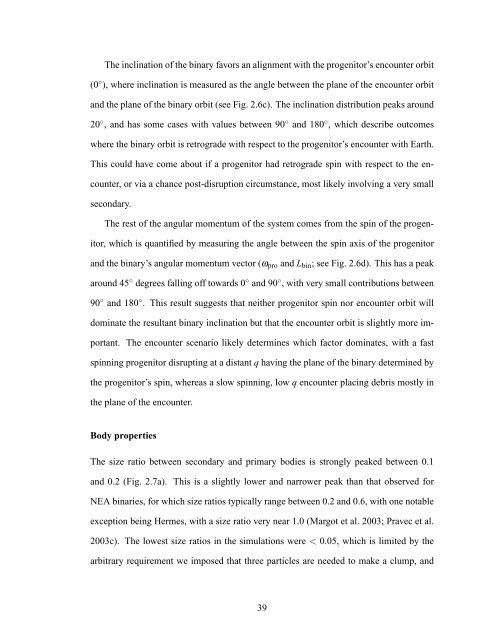Forming Binary Near-Earth Asteroids From Tidal Disruptions
Forming Binary Near-Earth Asteroids From Tidal Disruptions
Forming Binary Near-Earth Asteroids From Tidal Disruptions
Create successful ePaper yourself
Turn your PDF publications into a flip-book with our unique Google optimized e-Paper software.
The inclination of the binary favors an alignment with the progenitor’s encounter orbit(0 ◦ ), where inclination is measured as the angle between the plane of the encounter orbitand the plane of the binary orbit (see Fig. 2.6c). The inclination distribution peaks around20 ◦ , and has some cases with values between 90 ◦ and 180 ◦ , which describe outcomeswhere the binary orbit is retrograde with respect to the progenitor’s encounter with <strong>Earth</strong>.This could have come about if a progenitor had retrograde spin with respect to the encounter,or via a chance post-disruption circumstance, most likely involving a very smallsecondary.The rest of the angular momentum of the system comes from the spin of the progenitor,which is quantified by measuring the angle between the spin axis of the progenitorand the binary’s angular momentum vector (ω pro and L bin ; see Fig. 2.6d). This has a peakaround 45 ◦ degrees falling off towards 0 ◦ and 90 ◦ , with very small contributions between90 ◦ and 180 ◦ . This result suggests that neither progenitor spin nor encounter orbit willdominate the resultant binary inclination but that the encounter orbit is slightly more important.The encounter scenario likely determines which factor dominates, with a fastspinning progenitor disrupting at a distant q having the plane of the binary determined bythe progenitor’s spin, whereas a slow spinning, low q encounter placing debris mostly inthe plane of the encounter.Body propertiesThe size ratio between secondary and primary bodies is strongly peaked between 0.1and 0.2 (Fig. 2.7a). This is a slightly lower and narrower peak than that observed forNEA binaries, for which size ratios typically range between 0.2 and 0.6, with one notableexception being Hermes, with a size ratio very near 1.0 (Margot et al. 2003; Pravec et al.2003c). The lowest size ratios in the simulations were < 0.05, which is limited by thearbitrary requirement we imposed that three particles are needed to make a clump, and39












